Spotify Marketing Strategy to Keep People Streaming Music
It is always fascinating to see a new brand shaking up the market and provide new solutions to the consumers. For marketing-wise, looking at a brand’s content shows its process, creativity, and valuable insights. Some companies, such as Spotify, seem to be wizard-like with its marketing campaigns. Hitting home run after home run with simple yet effective marketing tactics, Spotify now has 286 million users.
Spotify is considered a part of the media’s future with its streaming service. But, the future is often debating, and Spotify has faced many controversies as well as competition. It has come under fire from artists and producers like Taylor Swift and Thom Yorke about its business model while having disputes with Apple - a giant tech company.
Despite all of that, Spotify still became the largest music streaming platform in the world. How did the company keep people streaming music on its platform against all the odds? Spotify’s marketing strategy plays a big role in its success, and that is what we are going to analyze in this article. Let’s play the music loud!
Related Articles
- Toyota Marketing Strategy
- M&M’s Branding Strategy
- Lululemon Marketing Strategy
- Colgate Advertising Strategy
- Zara Marketing Strategy
- Dove Marketing Strategy
Introduction

Spotify is a streaming music platform developed in Sweden in 2006 and launched in 2008. It provides a freemium service, which means basic features are free but come with advertisements and limited song skips. For additional features such as commercial-free listening and offline downloads, users need a paid subscription. The platform is available in the US, most of Europe, Australia, parts of Africa, Asia, and New Zealand. It can be used on Windows, macOS, Linux computers, and smartphones and tablets using iOS or Android.
As of April 2002, Spotify had 286 million active users monthly, including 130 million paying users. In 2019, the company’s revenue was $7.44 billion - a 29% increase from the year prior. It was announced in 2020 that Spotify acquired the license to the Joe Rogan Experience - a famous YouTube podcast led by Joe Rogan. The deal’s value was reportedly over $100 million.
Unlike physical sales or downloads, paying artists a fixed price for each song or album sold, Spotify pays royalties based on the number of artist streams as a percentage of the total songs streamed on the platform. It distributes about 70% of the total revenue to rights holders, who then pay the artists based on agreements. This got Spotify criticism from artists and producers like Taylor Swift and Thom Yorke, who has argued that the business model is not beneficial for musicians.
In 2013, Spotify launched a website called “Spotify for Artists”, which explained the business model and artists’ streaming data. This has then been the portal for artists, musicians, and podcasters to set up and release their products. However, independent artists would need to work with a distributor or record label to put their products on Spotify. There are also features to help artists promote their works, such as an ad, marquee, profile tools, canvas, and data.
Spotify marketing mix
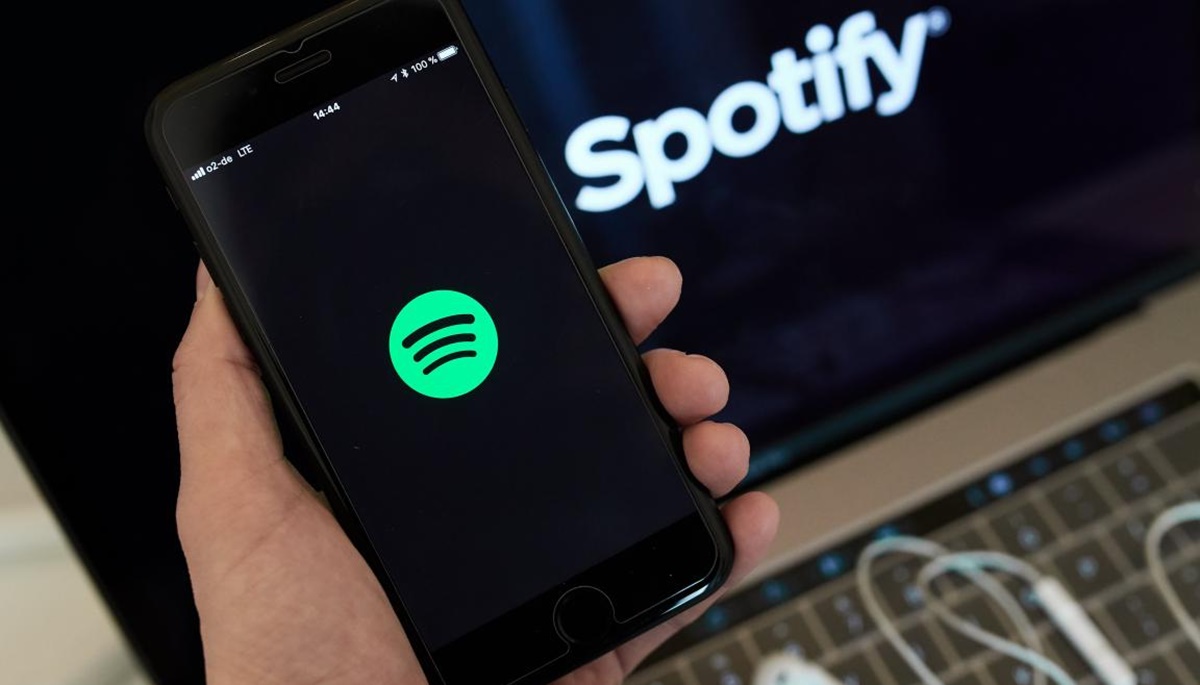
A marketing mix is a set of components that fit together to form a marketing strategy for a brand. With Spotify, we will use a marketing mix of the 4 P’s - Product, Price, Place, and Promotion. This should give a grand picture of how Spotify applies its marketing strategy to grow the business.
Spotify Product
Spotify’s core product is the music available on its platform. Content is digital, which means that consumers can access their products on their mobile devices, and based on the type of account users have, they also have the option to download content to listen offline. While traditional forms of music consumption (cassettes or cd tapes), users are must purchase specific equipment (cassettes players and CD players).
For different types of accounts offered by Spotify, users can have different experiences. Premium accounts allow users to download music, select the type of content they want, avoid advertising audios, and infinitely skips through songs. In contrast, Free accounts only let users listen to content online and only play an album in ‘shuffle’ mode.
Spotify Price
Spotify offers users two options: listening to their content for free or paying a subscription fee that can be canceled at any time on a premium account. As a freemium pricing model, free users are required to listen to ads every few songs that provide revenue for Spotify. There are four premium pricing models based on the user’s need: Individual ($9.99 / month for 1 account), Duo ($12.99 / month for 2 accounts), Family ($14.99 / month for up to 6 accounts), Student ($4.99 / month for 1 account).
Spotify Place
Traditional places where users can find or buy music content are a music store, a record store, or even a general electronics store. For me, it was walking down the street to see a pop-up store on the pavement. However, Spotify’s online platform makes the content more accessible to users around the world through the internet. It’s also possible to sell music on DistroKid and have it made available to stream on Spotify and across a host of other rival services, so there are more options for artists as well.
Spotify Promotion
Spotify has a diverse approach to promotion. The brand has a close relationship with the social media platform Facebook and displays many ads not only in the sidebar but also with sponsored posts on the users’ feeds. Word of mouth also played a big part in Spotify’s growth. During its US launch, free Beta testing was a way to attract consumer’s interest and potential new customers.
Spotify marketing strategy
With an overview of Shopify, we have understood more of the company’s products and marketing components. Now, let’s look at the Spotify marketing strategy to see how it gained the current position as a top music streaming platform. In fact, not many other competitors have even come close to the number of users that Spotify has.
A freemium model

Spotify has a freemium model with most of its users streaming music to their mobile phones or desktop computers via applications or web browsers. Free users receive ads between songs, which are part of the Spotify revenue model. They encounter audio ads every five or six songs, or about three minutes of advertising per hour of listening. Free users on mobile devices can’t skip through songs and have to play a list in shuffle mode.
Although these ads can be annoying after a while, most people love free stuff and want to share news about cool free stuff to their friends. Having a platform that can advertise to millions of users also ensures that Spotify is being talked about among brands’ marketers in the hope of promoting their brands through the service.
A shared human experience
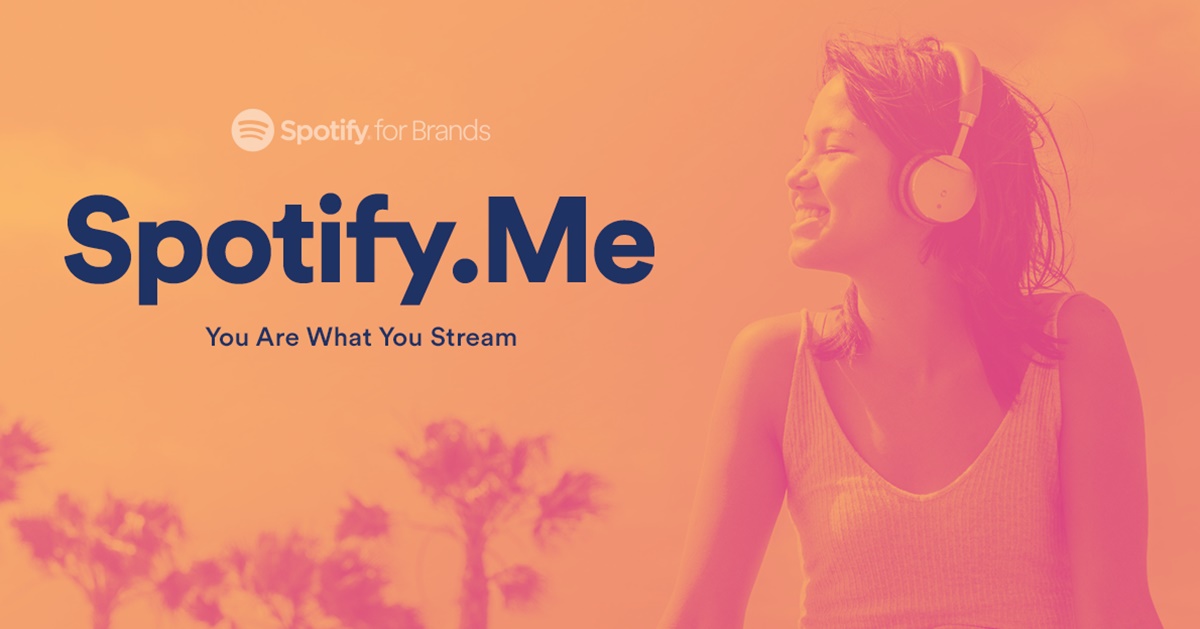
Music is for sharing, and Spotify often highlights this in its marketing campaigns. By making the streaming service have a great purpose in connecting people through music, the brand gains interest and appreciation from users.
In 2013, Spotify launched its first advertising campaign, when it faced growing competition from major companies like Apple, Google, and Amazon, all of which are rumored to be launching their own music streaming services. The campaign highlights the immense emotional power of music and its impact on the human experience. By an emotional voice, the narrator said why music is worth fighting for: “Because it is music”.
A year later, Spotify launched the #thatsongwhen campaign. Few things can evoke memories like music. Spotify used that emotional connection in a new social media environment to invite users to share their songs and the stories connected to them. Users could upload a photo along with their story and #thatsongwhen hashtag to share on social media, further enhancing the brand’s visibility and reach.
A sense of exclusivity

In their original release campaign, Spotify asked new users to provide their email to the company to be invited as the service’s users. It created quite a viral effect for the app, with users having only 5 invitations to share with friends.
The same strategy has contributed to the rapid rise of other digital-based service goliaths, Facebook, and Google Plus. The scarcity of a streaming service like Spotify makes it seem cool and makes users feel like a part of an exclusive club.
While the platform was eventually available to everyone (as expected from the start), building this type of advertising behind a new brand can help achieve massive media coverage and ensure a position on the market for the business.
Use of big data

A lesson learned from Spotify’s marketing strategy is the true power of data. Sure, we are talking about an entertainment brand here, but the algorithm usage is undeniable. Spotify is so well designed for users to enjoy exploring new music and expanding their list of favorite songs. The platform learns about users’ behaviors, interests, past actions, and then uses a powerful algorithm to create customized playlists and personalized recommendations for each user.
It may seem simple and not very revolutionary, but the trick here is Spotify’s algorithm’s efficiency. Users can enjoy a customized and personalized service without any extra effort or fee. All they need to do is keep using the platform as a music player, and the algorithm would build many content ideas based on their behavior.
Using data and algorithms to track and predict user behavior is useful to build Spotify a loyal fan base. It also leads to millions of dedicated and engaged users who see value in paid services. Custom content makes it up and ahead of its competition for users who like to explore. Thanks to the algorithm and wise use of data, Spotify becomes the platform that works for users in every interaction, bringing the best experience.
Naturally, satisfied users spread their words about Spotify to their friends and families. Riding this word of mouth effect, Spotify could connect more and more people as new users, while perfecting its algorithm even more.
A collaboration for content

Another creative marketing tactic that Spotify uses is collaborating with artists to get exclusive content. Again, this is not an unfamiliar technique, or even innovative to most marketers. However, it is the quality of Spotify’s content and seamless integration into the platform that sets it apart from other competitors.
Remember: users often want to take a few steps as possible. This applies to content consumption as well. Shopify integrated visual and audio content within the music (free) users are listening seamlessly, making the artists’ works more reachable. This is a big reason why more and more artists are now officially publishing their music on Spotify. For premium users, they see a beautifully designed banner that invites them to check out an artist’s work.
Not with just music, Spotify is trying to innovate the podcast streaming market as well. In 2020, it signed a $100 million contract with Joe Rogan to get an exclusive license over the Joe Rogan Experience. This famous YouTube podcast featured celebrities like Robert Downey Jr., Elon Musk, and Mike Tyson.
The streaming service is getting more and more competitive, so all brands must strive to create value for their customers. Spotify seems to be creating valuable content that users enjoy and keeping that momentum up by always giving customers the most personalized experience as possible.
Spotify best marketing campaigns
Spotify’s marketing strategy is effective but hard to replicate. Why? Because Spotify’s marketing campaigns are often endlessly relatable and hit the target audience right in the heart. Let’s take a closer look at the best campaigns made by Spotify to prove this point. There are memorable campaigns for each year, showing how consistent Spotify has been with its marketing effort.
2016 campaign: Embracing a strange year
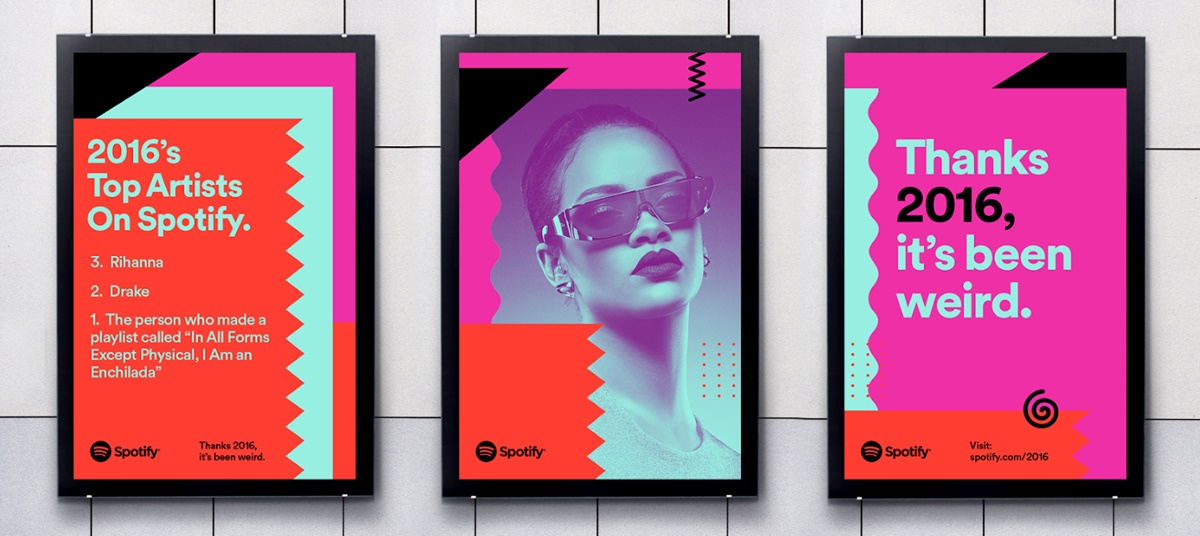
2016 was truly a strange year. Trump won the election, Brexit happened, many celebrity deaths, and the mannequin challenge. Leonardo Dicaprio finally won an Oscar while Mercury is permanently left behind. 2016 was also the first year Spotify implemented a data-based marketing campaign. The campaign did one great thing: it connected Spotify users to Spotify. It shows that Spotify’s staff pay close attention to users’ personal music choices and care about their lives. Not like some other companies who gather data and sell it away. Instead, you imagine how the staff of Spotify got together and laughed at everyone’s quirks.
Spotify also admitted to users that 2016 was strange. You were not the only one who feels weird about it. The message united the audience with Spotify and other listeners.
2017 campaign: Setting goals for 2018
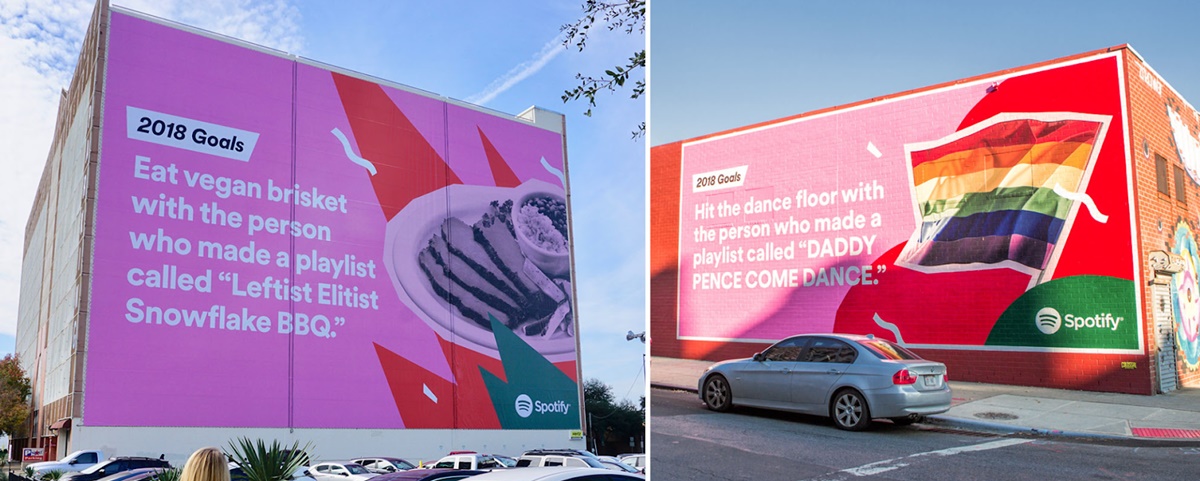
2017 was a great year for Spotify. Its revenue increased by 40% - making it the right time to attract more attention from the world and state itself loud and clear, which is exactly what Spotify did.
#goals was a really popular hashtag in 2017. It is still in use today, although not so often. You can still view stories and images that have hashtags like #lifegoals, #relationshipgoals, #adulthoodgoals, #hairgoals… and more. During Christmas 2017, Spotify launched a campaign that highlighted goals for 2018. It was all about music and, again, it revealed the habits of Spotify listeners in a hilarious way.
The campaign was a huge success: There was an increase in subscribers, increased brand awareness, and Spotify showed that it really cared about user data and anonymity. Besides, users now know they can be featured on personalized content, encouraging them to explore their music even more.
2018 campaign: Wrapping up the year
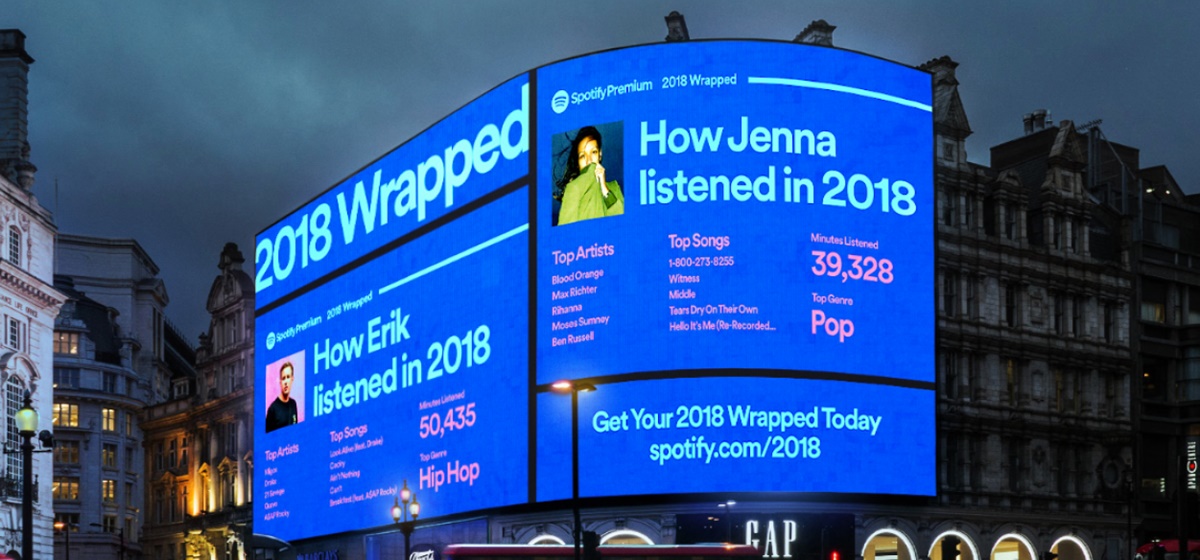
It’s always helpful to have tons of data about your users. Spotify knows what you listen to when you’re happy, when you’re sad, and when you’re using the shower. In 2018, they decided to use this information for a creative marketing campaign. It is interesting and exciting to discover the habits of others. Besides, the campaign makes creating playlists a process valued by Spotify.
The next thing to do is jumping on the current trends. What is your target audience talking about on social media? What topic is on fire at the moment? Game of Thrones? Politics? Celebrities?
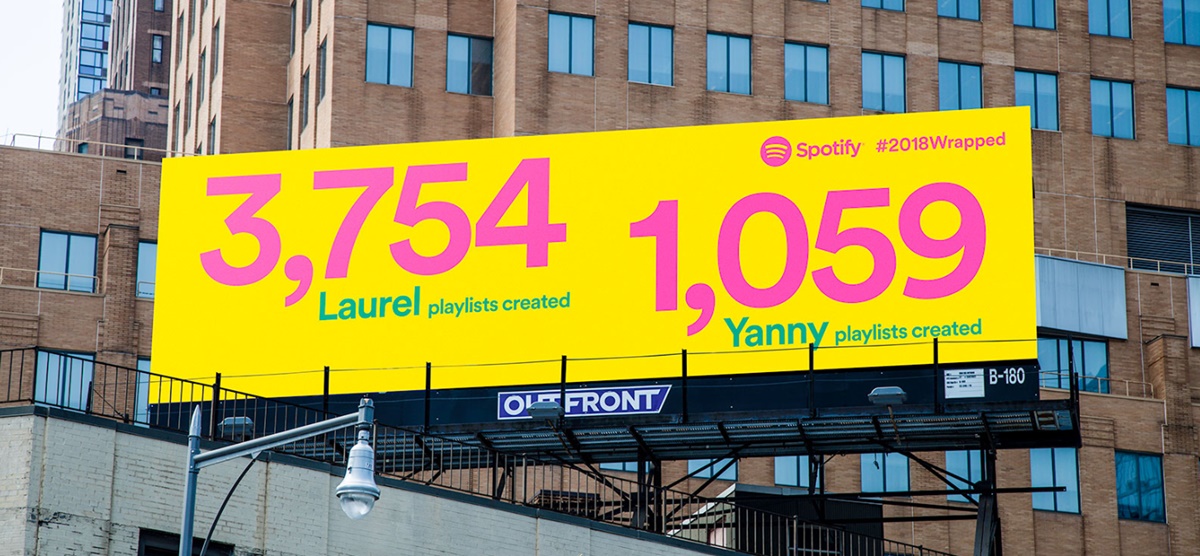
In 2018, there was a funny auditory illusion that divided people (it was the dress color thing all over again). In a brief recording, 53% of more than 500,000 people responded on a Twitter poll that they heard a man say “Laurel”, while 47% reported hearing a voice saying “Yanny”. Spotify caught the trend and hired a hilarious billboard for it.
Campaigns like this turned Spotify into a pop culture master and attracted its target audience to participate in the fun with the music-streaming platform.
2019 campaign: Streaming content for every mood
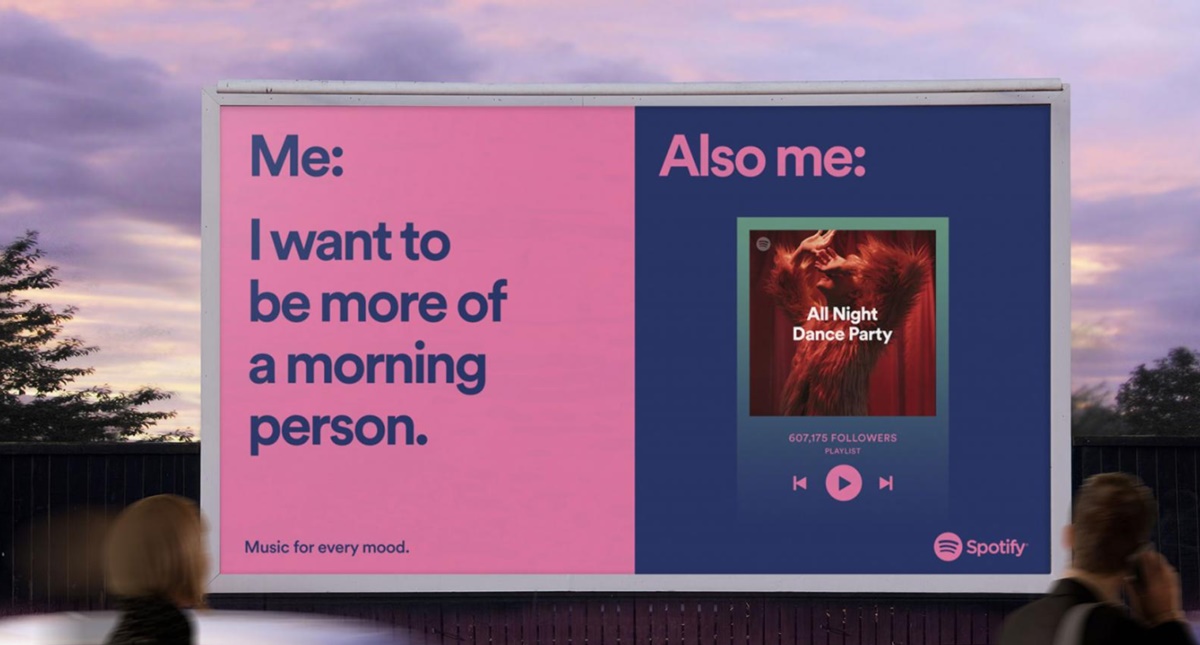
Spotify aims to strengthen its relationship with millennials and gen Z, and using memes was the ultimate way. Memes are the kind of pop culture that makes you feel like the world understands you and you understand the world with super relatable pictures. Also, they are really funny, boomers may not get this, but they are! Let us introduce you to who millennials are and what they are going to buy
But finding the right meme is not enough. Spotify also needs to understand its target audience and deliver content that mass audiences enjoy. So Spotify chose to highlight how millennials like to self-sarcasm on its billboards, like the one above.
The campaign also promoted Spotify podcasts, letting users know that the streaming service has a podcast for every mood. Maybe you should try listening to a thrilling podcast when ironing clothes. After all, Agatha Cristie herself said: “The best time to plan a book is while doing the dishes”. And Spotify has the podcasts for your one-of-a-kind listening habit.
Further readings
- Why Is Starbucks So Popular?
- Heineken Branding Strategy To Be The World’s Top Beer Brand
- Toms Shoes: How the right Marketing Strategy creates a Half-Billion-Dollar Brand
Ready to turn up the volume?
Marketing a product or service has gotten harder every day, with more competitors showing up every second. By focusing its effort on creating a personalized user experience and hilariously relatable campaigns, Spotify continues to grow with more customers than ever. Try taking a page out of Spotify’s marketing strategy book helps any business that is trying to stand out on the market.
What do you think? Are you ready to turn up the volume and let your target audience hear you loud and clear? In modern days, either you get heard or get lost in the ocean of information presented to users each day. Share your ideas or strategy in the comments section below, and thanks for reading!
New Posts






